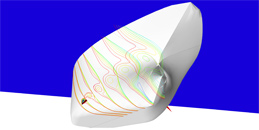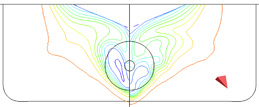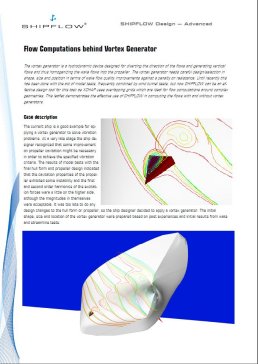CFD computations of the flow behind a vortex generator
The vortex generator is a hydrodynamic device designed for diverting the direction of the flows and generating vertical flows and thus homogenizing the wake flows into the propeller. The vortex generator needs careful design/selection in shape, size and position in terms of wake flow quality improvements against a penalty on resistance. Until recently this has been done with the aid of model tests, frequently combined by wind tunnel tests, but now SHIPFLOW can be an effective design tool for this task as XCHAP uses overlapping grids which are ideal for flow computations around complex geometries. This leaflet demonstrates the effective use of SHIPFLOW in computing the flows with and without vortex generators.
Case description
The current ship is a good example for applying a vortex generator to solve vibration problems. At a very late stage the ship designer recognized that some improvement on propeller cavitation might be necessary in order to achieve the specified vibration criteria. The results of model tests with the final hull form and propeller design indicated that the cavitation properties of the propeller exhibited some instability and the first and second order harmonics of the excitation forces were a little on the higher side, although the magnitudes in themselves were acceptable. It was too late to do any design changes to the hull form or propeller, so the ship designer decided to apply a vortex generator. The initial shape, size and location of the vortex generator were prepared based on past experiences and initial results from wake and streamline tests.
Computations

SHIPFLOW computation were carried out with and without vortex generator at model scale in design condition. The background grid is generated by XGRID and the small component grid around the vortex generator is generated by XCHAP. In total 2,000,000 grid cells were used.
Results
The computed wake contour plots shown below clearly indicate a significant improvement in wake flow due to the installation of a vortex generator. The vortex generator has reduced the mean wake and the peak value of the wake at the upright position. The results of the calculations correspond well with the measurements.
 A comparison of the wake at the propeller plane with and without the vortex generator is presented below, the wake peak within the propeller disc is reduced and more even distribution is visible. A comparison of the wake at the propeller plane with and without the vortex generator is presented below. As can be seen, the wake peek within the propeller disc is reduced and the wake is also more evenly distributed. These computational results show good agreement with the measurements.
A comparison of the wake at the propeller plane with and without the vortex generator is presented below, the wake peak within the propeller disc is reduced and more even distribution is visible. A comparison of the wake at the propeller plane with and without the vortex generator is presented below. As can be seen, the wake peek within the propeller disc is reduced and the wake is also more evenly distributed. These computational results show good agreement with the measurements.
Concluding Remarks
SHIPFLOW can be effectively used for designing / optimizing wake improving devices, such as vortex generators, pre-swirl stators by using the powerful overlapping grid technique.


